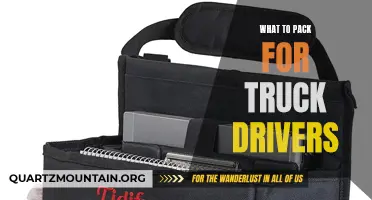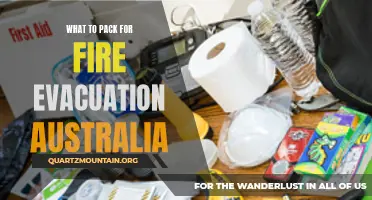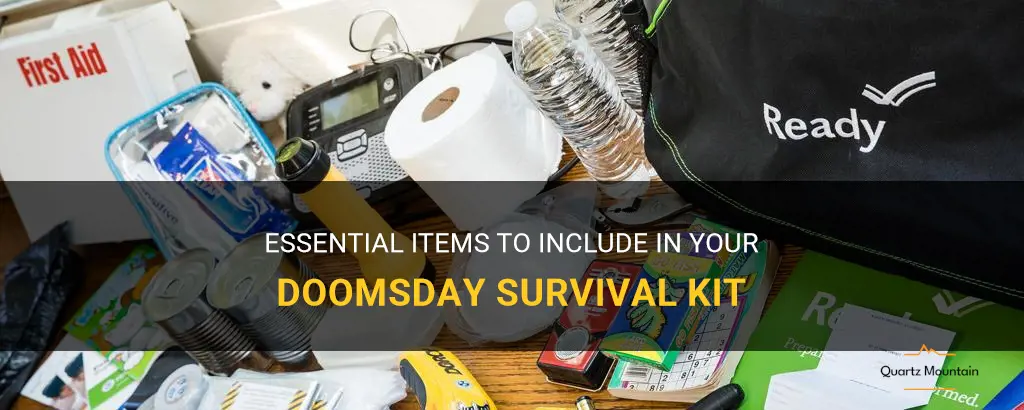
In a world of uncertainty, it is always wise to be prepared for the worst-case scenario. Whether it be a natural disaster or a zombie apocalypse, having a doomsday survival kit can mean the difference between life and death. But what exactly are the essential items that should be included in this kit? From food and water to first aid supplies and weapons, we will uncover the crucial elements that will aid in your survival during the end of the world as we know it. So buckle up and get ready, because you never know when you might need these essential items to save your life.
What You'll Learn
- What essential items should be included in a doomsday survival pack?
- How much food and water should be packed for an extended period of time?
- Are there any specific tools or equipment that should be included in a doomsday survival pack?
- What types of clothing or protective gear should be packed for various doomsday scenarios?
- Are there any additional items or supplies that are often overlooked but crucial for survival in a doomsday situation?

What essential items should be included in a doomsday survival pack?
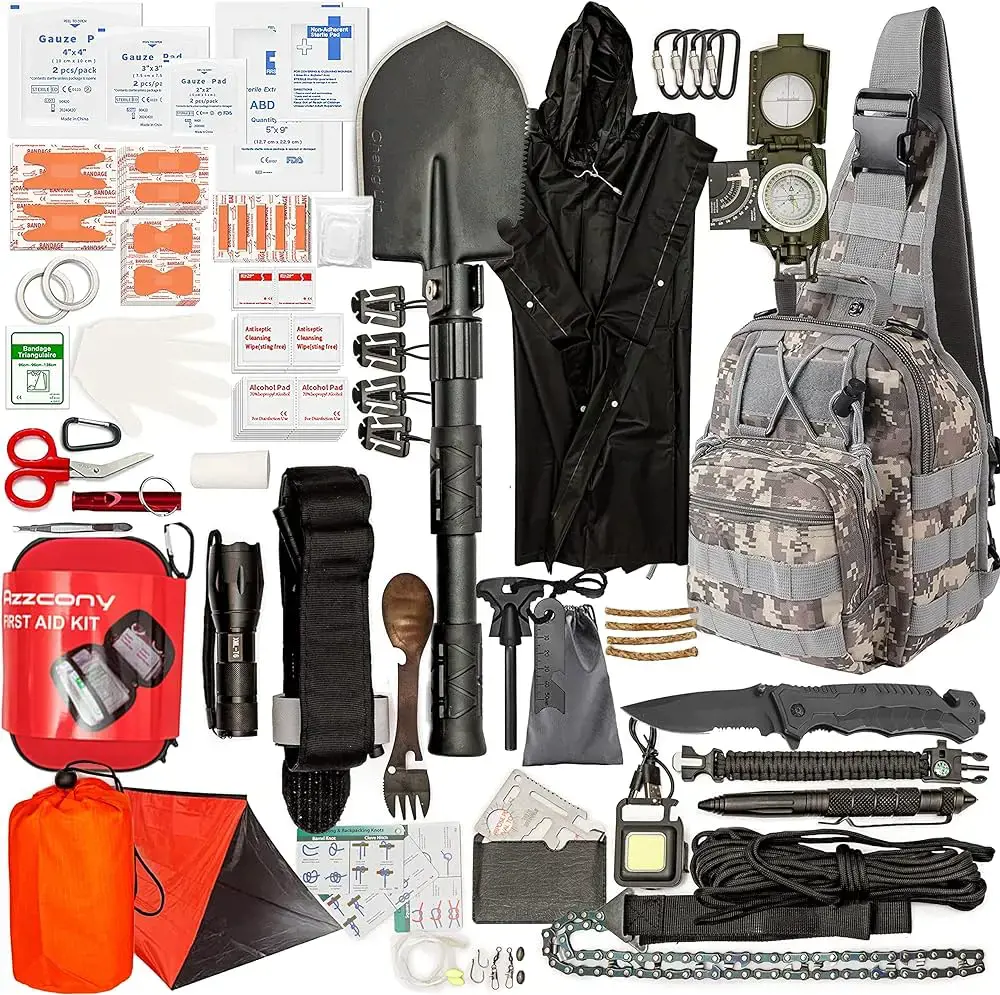
Preparing for a doomsday scenario can feel daunting, but having a well-stocked survival pack can greatly increase your chances of surviving and thriving in such circumstances. Whether you are facing a natural disaster, economic collapse, or any other apocalyptic event, there are several key items that should be included in your doomsday survival pack. Here we will discuss the essentials and why they are important.
- Water purification tools: In a doomsday scenario, access to clean drinking water may be limited. It is crucial to have the means to purify water to ensure your hydration and prevent waterborne diseases. Include items such as water filters, iodine tablets, and a durable water container.
- Non-perishable food: Stock up on high-calorie, non-perishable food items that can sustain you for an extended period. Examples include canned goods, protein bars, and dried fruits. Aim for a well-rounded selection that provides a balance of carbohydrates, proteins, and fats.
- First aid kit: In situations where medical help may be inaccessible, having a comprehensive first aid kit is essential. Include items such as bandages, antiseptics, pain relievers, and any prescription medications you require. Additionally, learn basic first aid techniques to effectively handle injuries.
- Tools and equipment: A sturdy multi-tool, a survival knife, and a lightweight camping stove are indispensable in a doomsday situation. They can be used for various tasks, such as building shelter, preparing food, or self-defense. Also, include a reliable flashlight, extra batteries, and a fire starter kit.
- Communication devices: To stay connected with the outside world or coordinate with fellow survivors, consider including a battery-powered radio and a hand-crank charger for your cellphone. These devices can provide essential updates, news, and potential rescue instructions.
- Protective clothing and gear: In harsh environments or when facing potential dangers, having appropriate clothing and gear is crucial. Pack sturdy shoes, warm clothing, rain gear, gloves, and a hat. Also, include a gas mask and goggles for protection against airborne toxins.
- Cash and important documents: In a catastrophic event, electronic payment systems may fail, and having cash on hand can be essential for purchasing supplies or services. Additionally, keep photocopies of important documents such as identification papers, insurance policies, and contact information.
- Personal hygiene items: Include basic personal hygiene supplies such as toilet paper, toothbrushes, toothpaste, soap, and hand sanitizer. Maintaining hygiene can help prevent illnesses and boost morale.
- Self-defense tools: While it is important to prioritize peaceful interaction and cooperation in a crisis, having self-defense tools can provide a sense of security. Consider including items like a pepper spray, a whistle, or a small firearm if you are trained and legally permitted to carry one.
- Mental and entertainment activities: A survival pack should include items to help alleviate stress and boredom. Pack playing cards, books, puzzles, or other forms of entertainment that can provide distraction and maintain mental well-being.
Remember that the items in your doomsday survival pack should be customized to suit your specific needs and situation. Regularly evaluate and update your supplies to ensure they are in good condition and not expired. Additionally, educate yourself on survival skills and emergency procedures to increase your chances of successfully navigating any doomsday scenario that may arise.
Essential Items to Pack for Your Trip to Broken Bow
You may want to see also

How much food and water should be packed for an extended period of time?
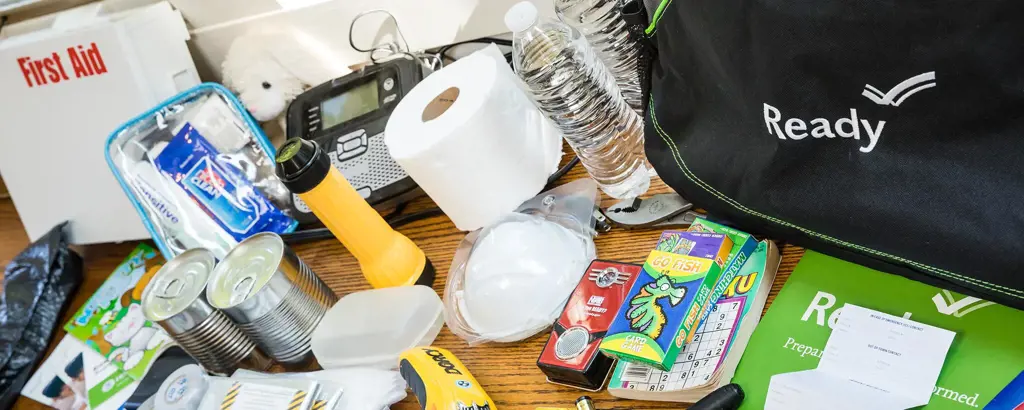
When preparing for an extended period of time away from civilization, such as during a camping trip or in an emergency situation, it is crucial to pack enough food and water to sustain oneself. The amount of food and water needed depends on various factors, including the duration of the trip, the individual's activity level, and the environment in which they will be residing.
Water is one of the most critical resources to have in abundance. The average person needs at least 2 liters (or half a gallon) of water per day to stay hydrated. This amount can increase significantly with increased physical activity or exposure to hot and dry environments. Therefore, it is recommended to pack enough water for a minimum of three days, but ideally for a week or more.
If there is a natural water source nearby, such as a river or lake, it is possible to filter and purify the water for consumption. However, it is still essential to pack a water filtration system or purification tablets as a backup. These devices will remove bacteria, viruses, and other contaminants, making the water safe to drink.
Aside from water, it is crucial to pack enough food to meet the body's energy requirements. The average adult needs around 2,000 to 2,500 calories per day, depending on their age, gender, and activity levels. However, this number can vary depending on individual factors such as metabolism and body composition.
When selecting food items, opt for non-perishable, high-calorie foods that are lightweight and easy to store. Examples include energy bars, dried fruits, nuts, and jerky. Canned goods, such as beans and tuna, also provide essential nutrients and have a long shelf life. It is important to consider any dietary restrictions or special needs when choosing food items, such as allergies or intolerances to certain ingredients.
To calculate the exact amount of food needed, consider the duration of the trip and the number of calories required per day. For example, if a person needs 2,500 calories per day and will be away for a week, they would need approximately 17,500 calories' worth of food. Divide this number by the calorie content of each food item to determine how many servings or packages to pack.
It is worth noting that in emergency situations, it is advisable to pack extra food and water in case of unforeseen circumstances or delays in rescue or resupply efforts. It is always better to have more provisions than necessary rather than running out when they are needed most.
In conclusion, when packing for an extended period of time away from civilization, it is important to ensure an adequate supply of food and water. Consider factors such as the duration of the trip, individual energy requirements, and the availability of water sources. Pack non-perishable, high-calorie foods and enough water to meet the body's needs. Always err on the side of caution and pack extra provisions in case of emergency situations.
Essential Items to Pack for an Unforgettable Trip to the Azores
You may want to see also

Are there any specific tools or equipment that should be included in a doomsday survival pack?
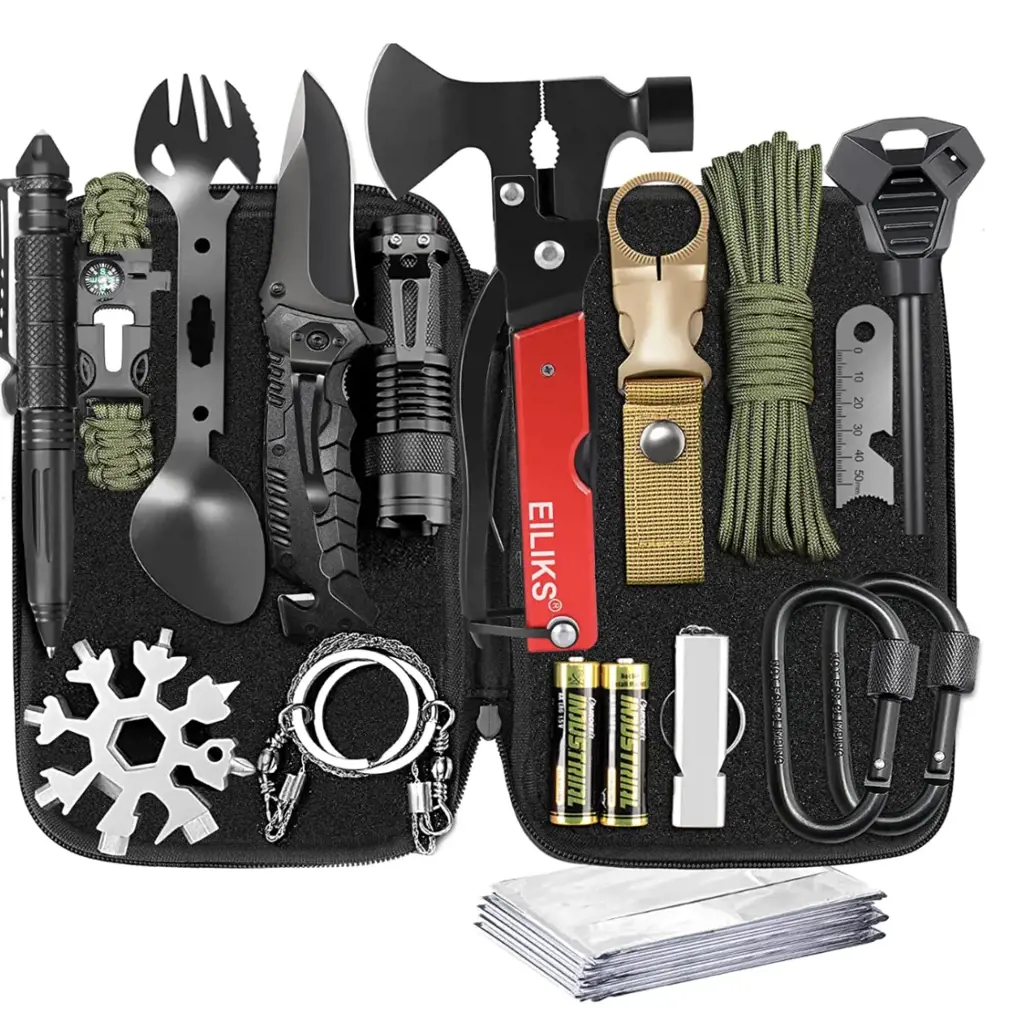
When it comes to preparing for a doomsday scenario, having the right tools and equipment in your survival pack can make all the difference. It's important to have items that can help you survive in any situation and provide the necessary resources for food, water, and shelter. In this article, we will discuss some of the essential tools and equipment that should be included in a doomsday survival pack.
- Multi-tool: A multi-tool is a versatile tool that combines several essential tools in one. It usually includes a knife, pliers, screwdrivers, and other useful attachments. A high-quality multi-tool is a must-have item in any survival pack as it can help with various tasks such as cutting, repairing, and opening cans.
- First Aid Kit: In a doomsday scenario, medical help might not be readily available. Having a comprehensive first aid kit that includes bandages, antiseptic, painkillers, and other essential medical supplies can be a lifesaver. Make sure to regularly check and replace any expired items in your first aid kit to ensure its effectiveness.
- Water Filtration System: Clean water is essential for survival, and having a reliable water filtration system is a must. Look for a portable water filter that can remove bacteria, viruses, and other contaminants from various water sources. Additionally, consider including water purification tablets or drops as a backup.
- Fire Starter: Fire provides warmth, light, and the ability to cook food. Including a reliable fire starter in your survival pack is crucial. A waterproof lighter or ferrocerium rod are excellent options as they can produce sparks in any weather condition. It's also a good idea to carry waterproof matches or a magnesium fire starter as backups.
- Emergency Shelter: In a doomsday scenario, having a proper shelter is vital for protection against the elements. Include an emergency shelter such as a lightweight tent, tarp, or space blanket in your survival pack. These items are compact, lightweight, and easy to set up, making them ideal for emergency situations.
- Navigation Tools: In a post-apocalyptic scenario, GPS and other electronic navigation systems may not be functional. Having reliable navigation tools is crucial for finding your way. Include a handheld compass, topographic maps of your area, and a signaling device like a whistle or mirror to attract attention if necessary.
- Food Rations: Including non-perishable food in your survival pack is essential. Look for high-calorie energy bars, dehydrated meals, or long-lasting food items that require minimal preparation. Don't forget to pack a can opener or a multi-tool with a can opener attachment for opening canned food.
- Multi-purpose Rope: Pack a strong and versatile rope, such as paracord, as it can be used for a variety of purposes like setting up shelters, securing gear, or creating makeshift tools. Paracord can also be unraveled to provide smaller strands of cordage for other purposes.
- Personal Protection: In a doomsday scenario, personal protection might be necessary. Consider including personal defense items like pepper spray, a sturdy survival knife, or a compact self-defense weapon in your survival pack. It's important to familiarize yourself with any self-defense item and practice proper usage before relying on it.
- Communication Devices: Having a way to communicate with others is vital in a post-apocalyptic scenario. Include a portable radio or a two-way communication device like a walkie-talkie in your survival pack. These devices can help you stay informed about any rescue efforts or connect with other survivors.
It's important to note that the items listed above are just the basics and should be customized to suit your specific needs and the type of doomsday scenario you are preparing for. Additionally, regularly check and maintain your survival pack to ensure that all items are in good working condition and replace any expired or damaged items.
In conclusion, preparing a doomsday survival pack is crucial for being prepared in a worst-case scenario. By including essential tools and equipment such as a multi-tool, first aid kit, water filtration system, fire starter, emergency shelter, navigation tools, food rations, multi-purpose rope, personal protection items, and communication devices, you can increase your chances of survival and be better equipped to handle the challenges of a doomsday scenario.
Essential Items to Pack for a Two-Year Study Abroad Experience
You may want to see also

What types of clothing or protective gear should be packed for various doomsday scenarios?

When preparing for doomsday scenarios, it is important to consider the type of clothing and protective gear that should be packed. Different scenarios require different levels of protection and gear, so it's crucial to assess the potential risks and plan accordingly. This article will provide a general guide to help you determine what clothing and protective gear to pack for various doomsday scenarios.
Natural Disasters:
In the event of natural disasters such as hurricanes, floods, or earthquakes, you should prioritize functional and durable clothing. Here are some key items to consider:
- Waterproof and wind-resistant jackets or ponchos to stay dry.
- Sturdy boots with good traction to protect your feet.
- Long-sleeved shirts and pants to shield your skin from debris and insects.
- Safety helmets to provide head protection in case of falling objects.
- Gloves to protect your hands from sharp objects or potential contaminants.
- N95 masks to filter out harmful particles in the air if necessary.
Pandemic Outbreak:
In the case of a pandemic outbreak, such as a virus or contagious disease, personal protective equipment (PPE) becomes crucial. Here's what you should pack:
- N95 or N99 respirator masks to protect against airborne particles and viruses.
- Disposable gloves to minimize contact with contaminated surfaces.
- Coveralls or disposable gowns to shield your body from potential exposure.
- Goggles or face shields to protect your eyes from splashes or airborne droplets.
- Shoe covers to prevent tracking contaminated surfaces.
- Hand sanitizers or disinfectant wipes to maintain good hygiene.
Nuclear Fallout:
In the event of a nuclear disaster, protective clothing is essential to minimize exposure to radiation. Consider the following items:
- Full-body suits made of radiation-resistant material.
- Rubber or PVC boots that can be easily decontaminated.
- Respirator masks with filters designed to protect against radioactive particles.
- Rubber gloves that can be easily decontaminated or disposed of.
- Goggles or full-face respirators to protect against radioactive particles and gases.
Zombie Apocalypse:
While a zombie apocalypse may be a fictional scenario, it's always fun to consider what to pack in such a situation. Here are some suggestions:
- Sturdy, durable clothing to protect against zombie bites and scratches.
- Boots with good traction to help you outrun zombies.
- Utility belts or vests to carry essential supplies such as weapons, tools, and food.
- Face masks or goggles to protect against zombie blood or fluids.
- Mele weapons like baseball bats or knives for close combat.
Remember, these suggestions are not exhaustive and should serve as a starting point for your preparations. It's vital to research and tailor your clothing and protective gear to the specific doomsday scenario you're preparing for. Additionally, consider the climate and terrain of your area and pack accordingly. Regularly review and update your doomsday gear as new advancements or materials become available. With the right clothing and protective gear, you can increase your chances of survival in a doomsday scenario.
Essential Packing Tips for a July Trip to Europe
You may want to see also

Are there any additional items or supplies that are often overlooked but crucial for survival in a doomsday situation?
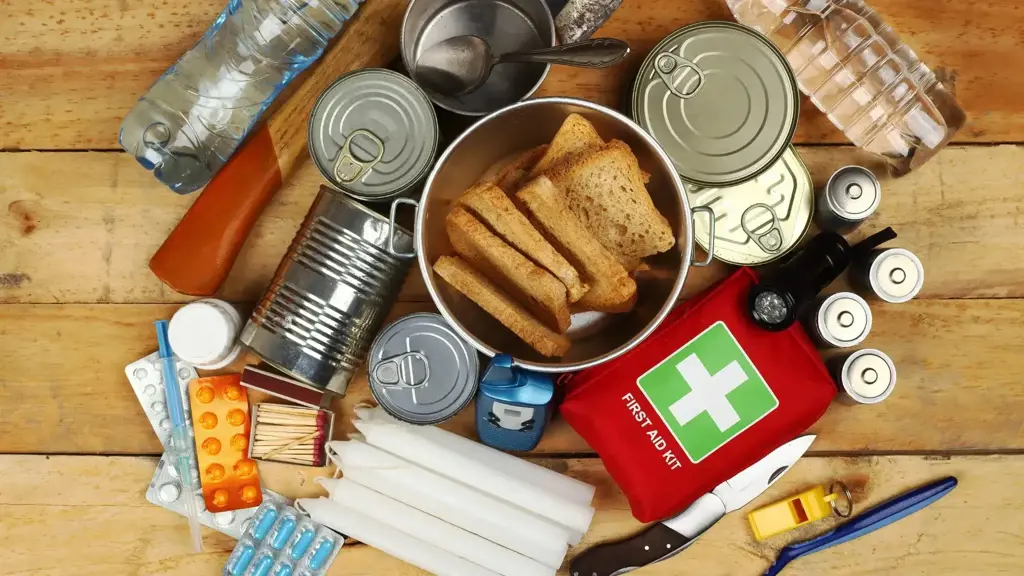
Preparing for a doomsday situation can be a daunting task, with many factors to consider. While most people tend to focus on the basic necessities such as food, water, and shelter, there are some additional items and supplies that are often overlooked but crucial for survival.
One often overlooked item is a good quality multi-tool. A multi-tool can come in handy in a variety of situations, from fixing equipment to building shelter. It usually includes essential tools such as pliers, a knife, a screwdriver, and a can opener. Having a multi-tool can make a big difference when it comes to surviving in a doomsday scenario.
Another crucial but often overlooked item is a portable water filter. While having clean water is vital for survival, many people focus on stockpiling water instead of considering alternative ways to purify it. A portable water filter allows you to filter water from various sources, such as rivers or lakes, making it safe for consumption. This can be a lifesaver if your stockpiled water runs out or becomes contaminated.
In a doomsday situation, communication is essential, and having a reliable communication device is crucial. While many people think of cell phones or radios, they often forget about the importance of having a hand-crank emergency radio. These radios can be operated by hand-cranking, generating power to listen to news updates, weather alerts, or even charge other devices. In a situation where traditional communication methods may be down, having an emergency radio can provide vital information and help maintain contact with the outside world.
One often overlooked aspect of survival in a doomsday situation is personal hygiene. While it may seem like a luxury, maintaining proper hygiene can prevent illness and keep you in good physical and mental health. Items such as soap, toothpaste, toilet paper, and feminine hygiene products should not be overlooked or underestimated. In a stressful and uncertain situation, taking care of your personal hygiene can help restore a sense of normalcy and well-being.
Lastly, it is crucial to have a backup source of power. While many people stockpile batteries, they often forget about the importance of having a portable solar charger. A portable solar charger can harness the power of the sun to charge various devices such as phones, flashlights, or radios. This renewable source of energy can be a game-changer and provide you with the power you need when other sources are unavailable.
In conclusion, when preparing for a doomsday situation, it's important to think beyond the basic necessities. Some often overlooked but crucial items and supplies include a multi-tool, a portable water filter, a hand-crank emergency radio, personal hygiene products, and a portable solar charger. These items can make a significant difference in your chances of survival and should not be underestimated. Remember to consider all aspects of survival and plan accordingly to increase your chances of thriving in a doomsday scenario.
What to Pack for a Disney Cruise in September: Essential Items for an Unforgettable Vacation
You may want to see also
Frequently asked questions
The most essential items to pack for doomsday include non-perishable food, water, a first aid kit, a multi-tool, a flashlight, batteries, a portable radio, extra clothing and blankets, a sturdy backpack, personal hygiene items, and any necessary medications. These items will ensure you have the necessary supplies for survival in the event of a doomsday scenario.
It is recommended to pack at least three days' worth of non-perishable food and one gallon of water per person per day for doomsday. This will provide enough sustenance to survive until further resources can be obtained. Additionally, consider packing water purification tablets or a water filtration system to ensure access to safe drinking water in case your initial supply runs out.
The decision to pack weapons for doomsday is a personal choice and depends on individual circumstances and beliefs. If you choose to pack weapons, make sure to comply with local laws and regulations. It is important to prioritize safety and ensure proper training and understanding of how to use any weapons you bring. Additionally, consider non-lethal options such as pepper spray or a stun gun for self-defense.




